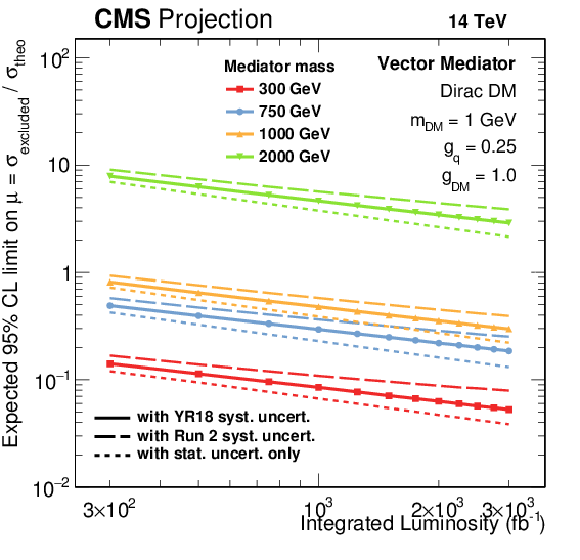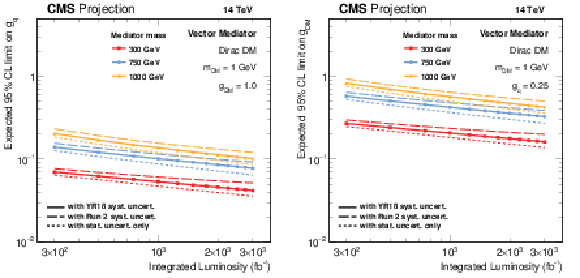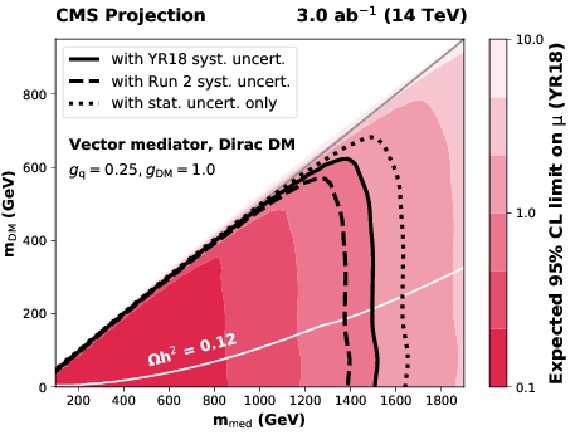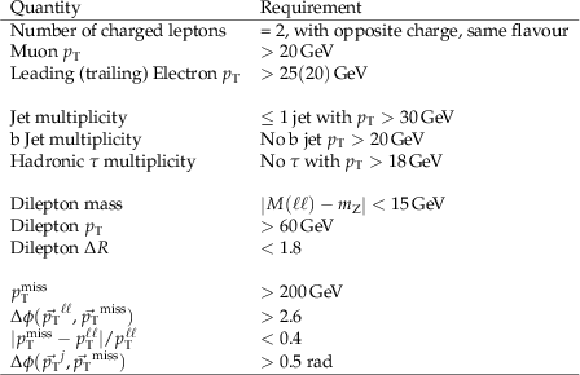

Compact Muon Solenoid
LHC, CERN
| CMS-PAS-FTR-18-007 | ||
| Projection of the Mono-Z search for dark matter to the HL-LHC | ||
| CMS Collaboration | ||
| October 2018 | ||
| Abstract: A study of the expected discovery sensitivity and exclusion power of a search for new invisible particles in events with a Z boson and missing transverse momentum at the high-luminosity LHC is presented. Sensitivity estimates are derived from a CMS Run 2 result with the use of rescaling techniques. Different scenarios of integrated luminosity and systematic uncertainties are explored, and results are presented in the parameter space of a simplified model of dark matter production with a spin-1 mediator, as well as a simplified model with a pseudoscalar mediator and second Higgs doublet.$ \textit{This document has been revised with respect to the version dated October 22, 2018.}$ | ||
| Links: CDS record (PDF) ; CADI line (restricted) ; | ||
| Figures | |

png pdf |
Figure 1:
Representative leading-order Feynman diagrams of the signal processes in the simplified model with a vector mediator $Z'$ and DM candidate $\chi $ (left), as well as the a+2HDM model (right). In the case of the a+2HDM scenario, box diagrams without a heavy scalar particle are also taken into account, but give a sub-dominant contribution in the parameter range of interest. |

png pdf |
Figure 1-a:
Representative leading-order Feynman diagram of the signal process in the simplified model with a vector mediator $Z'$ and DM candidate $\chi $. |

png pdf |
Figure 1-b:
Representative leading-order Feynman diagram of the signal process in the a+2HDM model. Box diagrams without a heavy scalar particle are also taken into account, but give a sub-dominant contribution in the parameter range of interest. |

png pdf |
Figure 2:
Spectrum of $ {p_{{\mathrm {T}}} ^\text {miss}} $ in the signal region. The summed background spectrum is overlaid with the spectra for two signal hypotheses. The uncertainty bands for the background prediction correspond to the YR18 uncertainty scenario described in the text and are shown both before and after applying a background-only maximum-likelihood fit to the Asimov dataset in signal and control regions ("prefit'' and "postfit'', respectively). |

png pdf |
Figure 3:
Expected discovery significance (left) and signal strength exclusion limits (right) for the vector-mediated DM signal as a function of $ \mathcal{L}_{{\mathrm {int}}} $ and for different values of the mediator mass. The results are shown for the three systematic uncertainty scenarios described in the text, with the scenario labeled as "Run 2'' corresponding to Ref. [4]. The significance is calculated for unity signal strength. |

png pdf |
Figure 3-a:
Expected discovery significance for the vector-mediated DM signal as a function of $ \mathcal{L}_{{\mathrm {int}}} $ and for different values of the mediator mass. The results are shown for the three systematic uncertainty scenarios described in the text, with the scenario labeled as "Run 2'' corresponding to Ref. [4]. The significance is calculated for unity signal strength. |

png pdf |
Figure 3-b:
Signal strength exclusion limits for the vector-mediated DM signal as a function of $ \mathcal{L}_{{\mathrm {int}}} $ and for different values of the mediator mass. The results are shown for the three systematic uncertainty scenarios described in the text, with the scenario labeled as "Run 2'' corresponding to Ref. [4]. |

png pdf |
Figure 4:
Exclusion sensitivity for the couplings $ {g_{q}} $ (left) and $ {g_{DM}} $ (right) in the vector-mediated DM scenario as a function of $ \mathcal{L}_{{\mathrm {int}}} $ and for different values of the mediator mass. The results are shown for the three systematic uncertainty scenarios described in the text, with the scenario labeled as "Run 2'' corresponding to Ref. [4]. Note that no limit can be set if the sensitivity for a given point is too low. For increasing values of $ {g_{q}} $ and $ {g_{DM}} $, the product of cross section and branching fraction eventually reaches a plateau and does not increase further with an increase in one of the couplings. Due to this effect, no coupling limits can be set for $m_{{\mathrm {med}}} = $ 2 TeV. |

png pdf |
Figure 4-a:
Exclusion sensitivity for the $ {g_{q}} $ coupling in the vector-mediated DM scenario as a function of $ \mathcal{L}_{{\mathrm {int}}} $ and for different values of the mediator mass. The results are shown for the three systematic uncertainty scenarios described in the text, with the scenario labeled as "Run 2'' corresponding to Ref. [4]. Note that no limit can be set if the sensitivity for a given point is too low. For increasing values of $ {g_{q}} $ and $ {g_{DM}} $, the product of cross section and branching fraction eventually reaches a plateau and does not increase further with an increase in one of the couplings. Due to this effect, no coupling limits can be set for $m_{{\mathrm {med}}} = $ 2 TeV. |

png pdf |
Figure 4-b:
Exclusion sensitivity for the $ {g_{DM}} $ coupling in the vector-mediated DM scenario as a function of $ \mathcal{L}_{{\mathrm {int}}} $ and for different values of the mediator mass. The results are shown for the three systematic uncertainty scenarios described in the text, with the scenario labeled as "Run 2'' corresponding to Ref. [4]. Note that no limit can be set if the sensitivity for a given point is too low. For increasing values of $ {g_{q}} $ and $ {g_{DM}} $, the product of cross section and branching fraction eventually reaches a plateau and does not increase further with an increase in one of the couplings. Due to this effect, no coupling limits can be set for $m_{{\mathrm {med}}} = $ 2 TeV. |

png pdf |
Figure 5:
Expected 95% CL exclusion limits on the signal strength of vector-mediated DM production in the plane of mediator and dark matter masses. The results are shown for the three systematic uncertainty scenarios described in the text, with the scenario labeled as "Run 2'' corresponding to Ref. [4]. The $ m_{{\mathrm {med}}} =2\times m_{{\mathrm {DM}}} $ diagonal, which is the kinematic boundary for decay of an on-shell mediator to DM particles, is indicated as a grey line. The white line indicates parameter combinations for which the observed DM relic density in the universe can be reproduced [32]. Points below (above) this line have relic densities that are larger (smaller) than the observed value of $\Omega h^{2} = $ 0.12 [33]. |

png pdf |
Figure 6:
Expected 95% CL exclusion limits on the signal strength in the a+2HDM scenario as a function of the mass of the main DM mediator a and the masses of the H and A bosons $ m_{{\mathrm {{\textrm {H}}}}} = m_{{\mathrm {{\textrm {A}}}}} $. The results are shown for the three systematic uncertainty scenarios described in the text, with the scenario labeled as "Run 2'' corresponding to Ref. [4]. The grey line indicates the kinematic boundary $ m_{{\mathrm {{\textrm {H}}}}} = m_{{\mathrm {{\textrm {a}}}}} + m_{{\mathrm {{\textrm {Z}}}}} $, below which the $ {\textrm {H}} \rightarrow {\textrm {a}} {\textrm {Z}} $ decay is prohibited for an on-shell H and the sensitivity of this search is limited. |
| Tables | |

png pdf |
Table 1:
Requirements for the signal region selection. The requirements fall in three categories: Lepton selection, vetoes based on the multiplicities of hadronic objects, dilepton candidate selection, and high-$ {p_{{\mathrm {T}}} ^\text {miss}} $ back-to-back topology requirements. The requirements are identical to those of Ref. [4], except for the $ {p_{{\mathrm {T}}} ^\text {miss}} $ requirement, which has been increased to remove increased background contributions at low $ {p_{{\mathrm {T}}} ^\text {miss}} $ due to degraded $ {p_{{\mathrm {T}}} ^\text {miss}} $ resolution at high PU. Jets are clustered using the anti-$ k_{{\mathrm {T}}} $ algorithm [22] implemented in the FastJet program [23] with a radius parameter of 0.4. Bottom quark jets are identified using the CSVv2 algorithm [24]. The dilepton angular separation is defined as $ {\Delta R} =\sqrt {(\eta (\ell _{1}) - \eta (\ell _{2}))^{2} + (\phi (\ell _{1}) - \phi (\ell _{2}))^{2}}$. |
| Summary |
| A sensitivity study for a search for dark matter (DM) particles in events with a Z boson and missing transverse momentum at the HL-LHC has been presented. The effects of the increase in integrated luminosity and center-of-mass energy, as well as the impact of changing experimental conditions and expected future improvements in the size of systematic uncertainties are taken into account. Assuming an integrated luminosity of 3 ab$^{-1}$, it will be possible to probe vector-mediated DM production up to values of the mediator mass of approximately 1.5 TeV. In a simplified model with a second Higgs doublet and a pseudoscalar mediator, heavy scalars will be probed up to masses of 1.9 TeV, and the light pseudoscalar mediator will be accessible up to masses of 600 GeV. A comparison of different scenarios of systematic uncertainties shows that even moderate differences in the size of uncertainties can significantly affect the size of the dataset necessary for discovery. Independent of the details of the systematic uncertainty treatment, significant improvements in the mass and coupling reach over current results are to be expected. |
| References | ||||
| 1 | D. Abercrombie et al. | Dark matter benchmark models for early LHC run-2 searches: Report of the ATLAS/CMS Dark Matter Forum | 1507.00966 | |
| 2 | M. Bauer, U. Haisch, and F. Kahlhoefer | Simplified dark matter models with two higgs doublets: I. Pseudoscalar mediators | JHEP 05 (2017) 138 | 1701.07427 |
| 3 | LHC Dark Matter Working Group | Next-generation spin-0 dark matter models | To be published | |
| 4 | CMS Collaboration | Search for new physics in events with a leptonically decaying Z boson and a large transverse momentum imbalance in proton-proton collisions at $ \sqrt{s} = $ 13 TeV | EPJC 78 (2018) 291 | CMS-EXO-16-052 1711.00431 |
| 5 | CMS Collaboration | Particle-flow reconstruction and global event description with the CMS detector | JINST 12 (2017) P10003 | CMS-PRF-14-001 1706.04965 |
| 6 | T. Melia, P. Nason, R. Rontsch, and G. Zanderighi | W+W-, WZ and ZZ production in the POWHEG BOX | JHEP 11 (2011) 078 | 1107.5051 |
| 7 | P. Nason and G. Zanderighi | $ W^+ W^- $ , $ W Z $ and $ Z Z $ production in the POWHEG-BOX-V2 | EPJC 74 (2014) 2702 | 1311.1365 |
| 8 | S. Frixione, P. Nason, and G. Ridolfi | A positive-weight next-to-leading-order Monte Carlo for heavy flavour hadroproduction | JHEP 09 (2007) 126 | 0707.3088 |
| 9 | M. Grazzini, S. Kallweit, and D. Rathlev | ZZ production at the LHC: fiducial cross sections and distributions in NNLO QCD | PLB 750 (2015) 407 | 1507.06257 |
| 10 | M. Grazzini, S. Kallweit, D. Rathlev, and M. Wiesemann | $ W^{\pm}Z $ production at hadron colliders in NNLO QCD | PLB 761 (2016) 179 | 1604.08576 |
| 11 | J. Baglio, L. D. Ninh, and M. M. Weber | Massive gauge boson pair production at the LHC: A next-to-leading order story | PRD 88 (2013) 113005 | 1307.4331 |
| 12 | A. Bierweiler, T. Kasprzik, and J. H. Kahn | Vector-boson pair production at the LHC to $ \mathcal{O}(\alpha^3) $ accuracy | JHEP 12 (2013) 071 | 1305.5402 |
| 13 | S. Gieseke, T. Kasprzik, and J. H. Kuhn | Vector-boson pair production and electroweak corrections in HERWIG++ | EPJC 74 (2014) 2988 | 1401.3964 |
| 14 | J. Alwall et al. | The automated computation of tree-level and next-to-leading order differential cross sections, and their matching to parton shower simulations | JHEP 07 (2014) 079 | 1405.0301 |
| 15 | R. Frederix and S. Frixione | Merging meets matching in MC@NLO | JHEP 12 (2012) 061 | 1209.6215 |
| 16 | M. Neubert, J. Wang, and C. Zhang | Higher-order QCD predictions for dark matter production in mono-Z searches at the LHC | JHEP 02 (2016) 082 | 1509.05785 |
| 17 | NNPDF Collaboration | Parton distributions for the LHC run II | JHEP 04 (2015) 040 | 1410.8849 |
| 18 | NNPDF Collaboration | Parton distributions from high-precision collider data | EPJC 77 (2017) 663 | 1706.00428 |
| 19 | T. Sjostrand et al. | An introduction to PYTHIA 8.2 | CPC 191 (2015) 159 | 1410.3012 |
| 20 | CMS Collaboration | Event generator tunes obtained from underlying event and multiparton scattering measurements | EPJC76 (2016), no. 3, 155 | CMS-GEN-14-001 1512.00815 |
| 21 | GEANT4 Collaboration | GEANT4--a simulation toolkit | NIMA 506 (2003) 250 | |
| 22 | M. Cacciari, G. P. Salam, and G. Soyez | The anti-$ k_t $ jet clustering algorithm | JHEP 04 (2008) 063 | 0802.1189 |
| 23 | M. Cacciari, G. P. Salam, and G. Soyez | FastJet user manual | EPJC 72 (2012) 1896 | 1111.6097 |
| 24 | CMS Collaboration | Identification of heavy-flavour jets with the CMS detector in pp collisions at 13 TeV | JINST 13 (2018) P05011 | CMS-BTV-16-002 1712.07158 |
| 25 | A. Buckley et al. | LHAPDF6: parton density access in the LHC precision era | EPJC 75 (2015) 132 | 1412.7420 |
| 26 | CMS Collaboration | The Phase-2 Upgrade of the CMS endcap calorimeter | CDS | |
| 27 | T. Junk | Confidence level computation for combining searches with small statistics | NIMA 434 (1999) 435 | hep-ex/9902006 |
| 28 | A. L. Read | Presentation of search results: the $ CL_{s} $ technique | JPG 28 (2002) 2693 | |
| 29 | G. Cowan, K. Cranmer, E. Gross, and O. Vitells | Asymptotic formulae for likelihood-based tests of new physics | EPJC 71 (2011) 1554 | 1007.1727 |
| 30 | ATLAS and CMS Collaborations, LHC Higgs Combination Group | Procedure for the LHC Higgs boson search combination in Summer 2011 | ATL-PHYS-PUB-2011-11, CMS NOTE 2011/005 | |
| 31 | CERN Yellow Report | HL/HE-LHC physics performance | To be published | |
| 32 | A. Albert et al. | Recommendations of the LHC Dark Matter Working Group: Comparing LHC searches for heavy mediators of dark matter production in visible and invisible decay channels | 1703.05703 | |
| 33 | Planck Collaboration | Planck 2015 results. XIII. Cosmological parameters | Astron. Astrophys. 594 (2016) A13 | 1502.01589 |

|
Compact Muon Solenoid LHC, CERN |

|

|

|

|

|

|